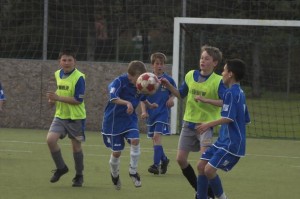In middle school, preschool, and pee wee leagues, the goalkeeper is often the forgotten player. As important as a position it is, not enough attention is given to this huge responsibility. Here are a few tips a youth coach can use, even if he’s not experienced in goalkeeping, to improve goalkeeper play without taking time away from training the positional players. If you’re the coach, you can tailor these drills and ideas to children of any age. 
Obviously, the goalkeeper’s main function is to prevent the ball entering his team’s goal. How he does it doesn’t really matter as long as he succeeds. Some goalkeepers like the spectacular and acrobatic looking methods while others prefer to be less eye-catching. Nevertheless, correct positioning by the goalkeeper will put him in the best area to deal with every situation.
The goalkeeper should take up a position on what is called the ‘bisector’. Draw an imaginary line from the ball to both the posts, now another line from the ball to the center of goal. This line, which equally divides the first two lines, is the ‘bisector’. This puts the goal¬keeper in a central position allowing equal space on both sides. If the goalkeeper positions himself on this line he is giving himself a chance to make a save on either side with a minimum amount of movement.
Although this principle should be applied when a direct shot is threatening, he must deviate from it in certain situations. When the ball is out on the flanks the goalkeeper should position himself closer to the far post in readiness to collect balls crossed into that part of the goalmouth. He should also be prepared to move forward quickly to deal with balls played into the near post area. When the ball is moved from the flanks closer to the goal, the goalkeeper should gradually move forward towards the near post because the danger of a direct shot is gradu¬ally threatening.
Here’s a basic practice drill that can go a long way in strengthening goalie skills. Groups of three players can help the goalkeeper with this technique. The first player with a ball runs at and commits the second player about 25 yards out from the goal. The goalkeeper’s position must be on the ‘bisector’ in preparation to deal with a possible shot. As the attacking player commits, the second player passes the ball out to the third player on the wing. According to how the ball is played the third player can now do one of two things. If the ball is played short he can bear in at goal and shoot. If the pass is longer then he can cross for the attacking player to head at goal under pressure from the defender. The goalkeeper must be aware of these situations and react quickly. The younger the player the less he’ll be able to be aware of his surroundings. Children of pee wee age might not even have the attention spans to fully know what’s going on all over the field. That’s ok…simply teach a kindergarten age player, or younger, one concept and take it from there.
As a coach, stop the play in order to check the keeper’s position. When play is deep in the opponent’s half, the goalkeeper should be encouraged to be about 12 yards out from goal, prepared to move forward to intercept long through-balls. As the play nears an area from which it’s possible for a direct shot, then the goalkeeper must retreat closer to his line in order to reduce the danger of a ball chipped over his head. During this period his attention should be focused on the ball and the movement of opponents.
Once the goalie leaves the goal-line he may have problems orientating himself. He may not be able to assess his own position in relation to the goal without looking back, which is a dangerous thing to do. When standing on the goal-line between the posts he can see them peripherally while still concentrating on the ball and players. Once he moves forward, this is no longer possible, so he must find other methods.
Encourage a goalie to find landmarks to use to position himself. The corners of goal area, the penalty spot, the corners and arc of the penalty area are all useful visual aids to help a goalie know where he is once he’s out of the goal. Situations change very quickly in soccer, especially around the box, so a goalie must get used to changing position with the situations without taking his eyes off the ball and the general movement. Goalkeeping is full of problems in positional play, but thought and practice, together with experience, will help a young player learn how to cope with them.


Need, Develop into successful at soccer! You need good work ethic. You need to train hard, and focus on your play. It has the power to transform lives, the power to bring a lifetime of joy.